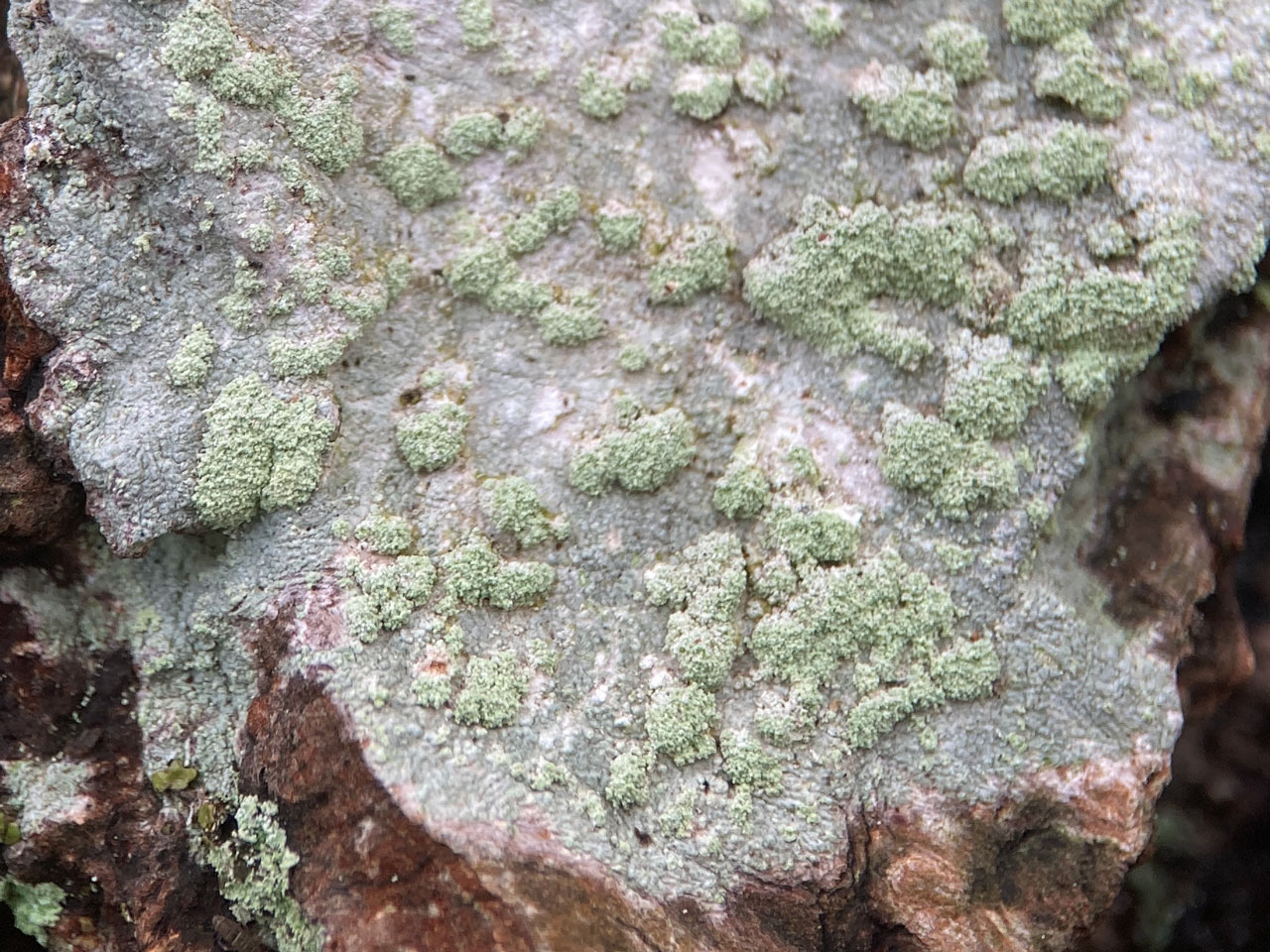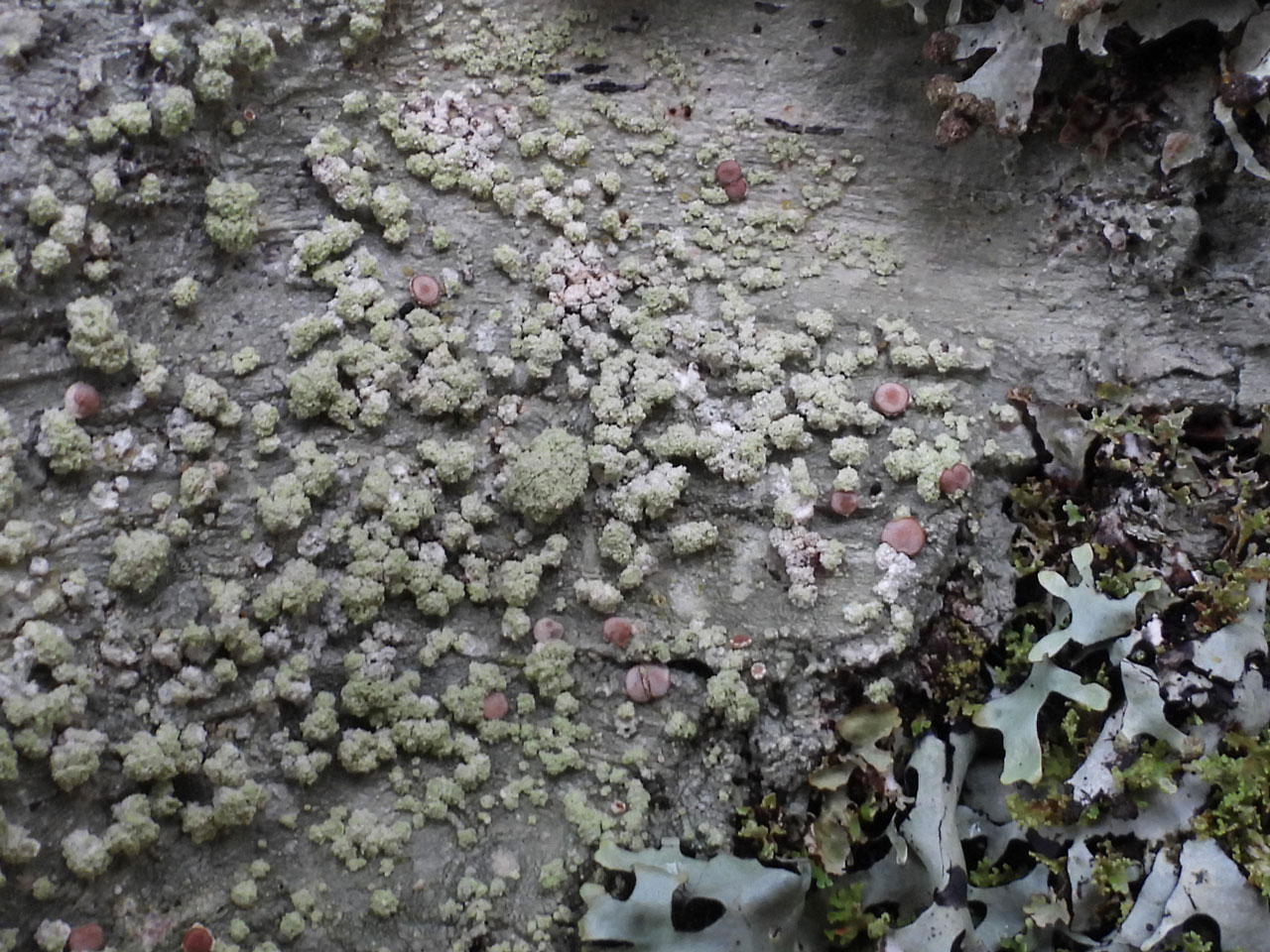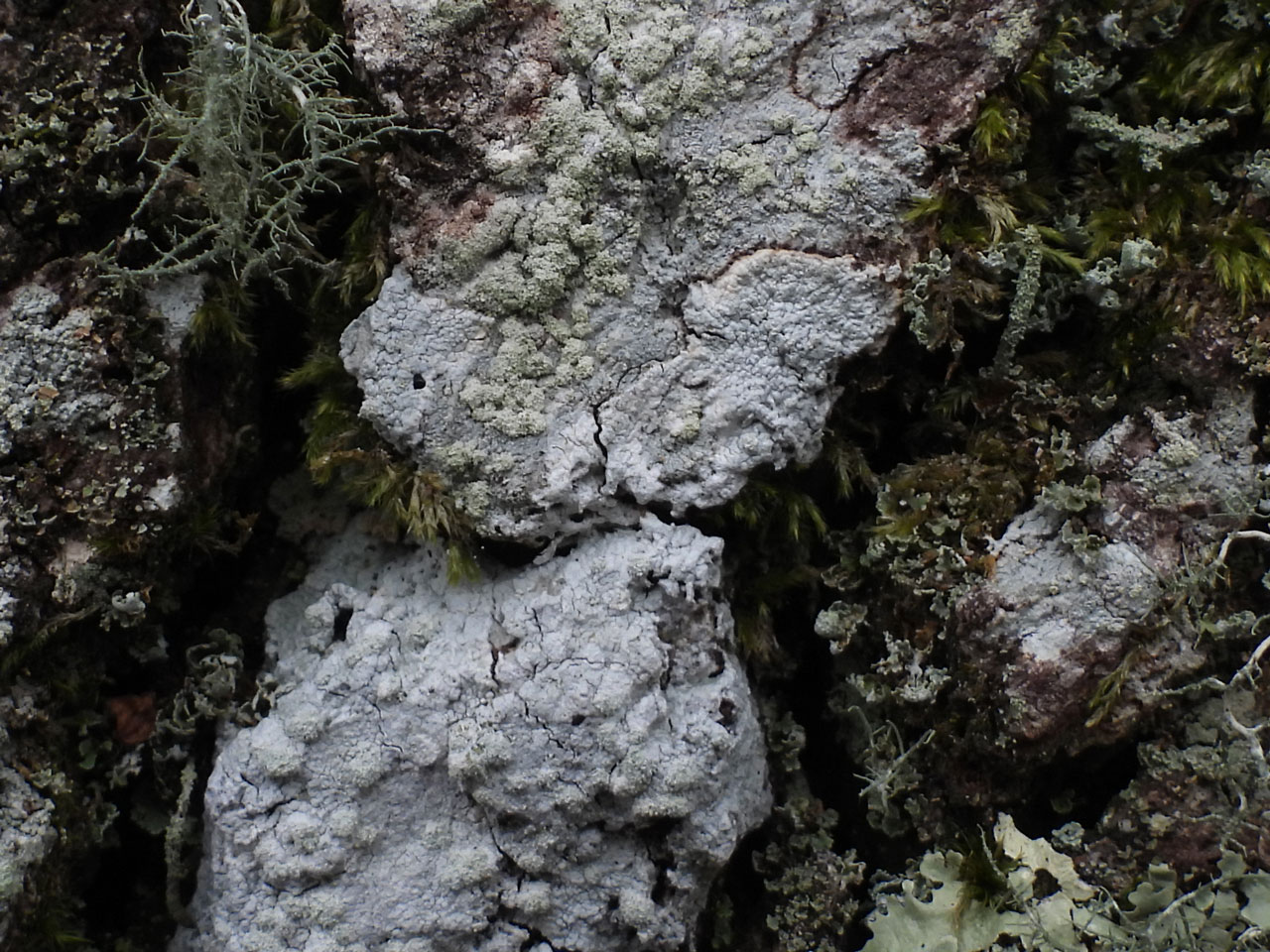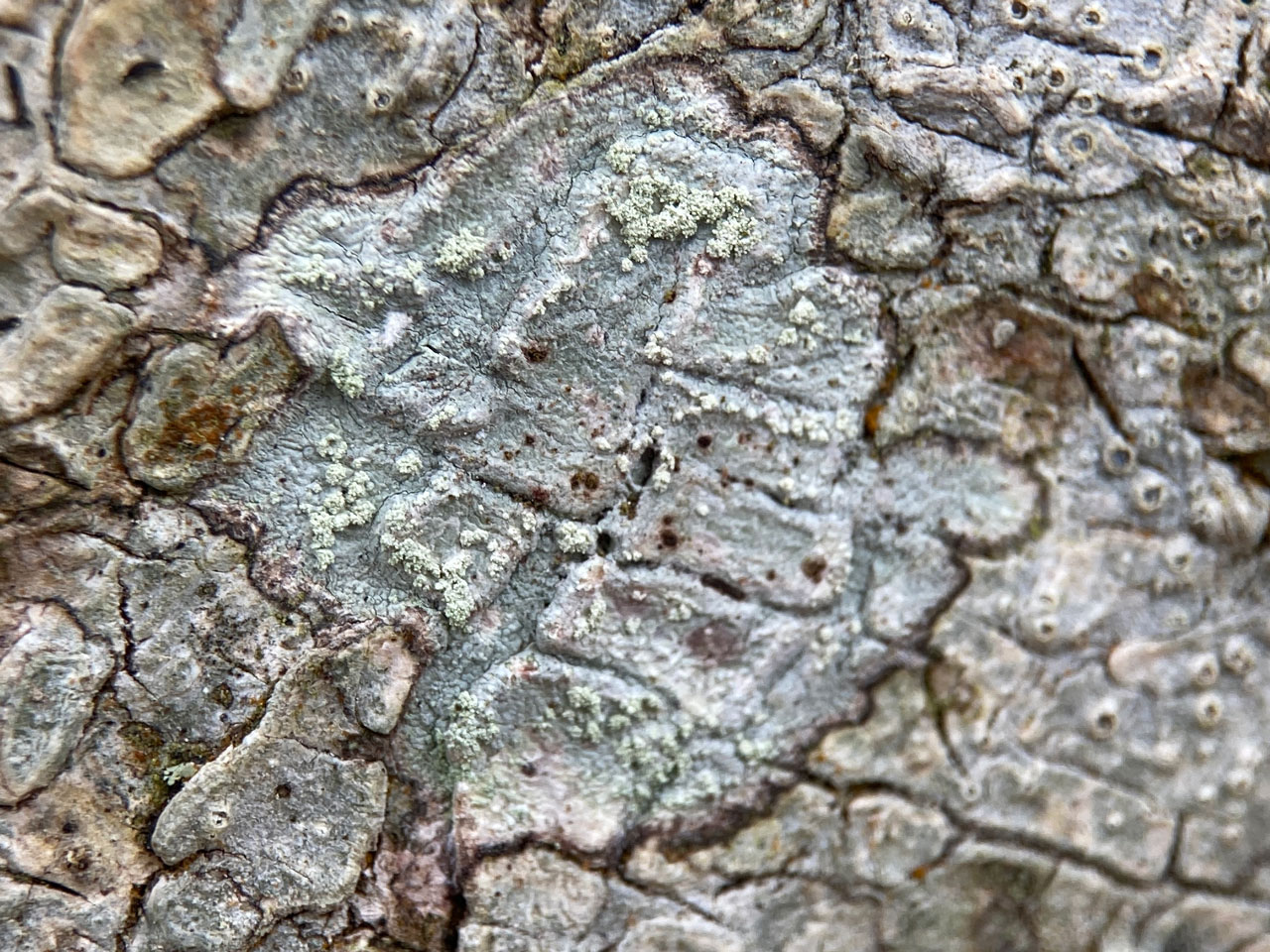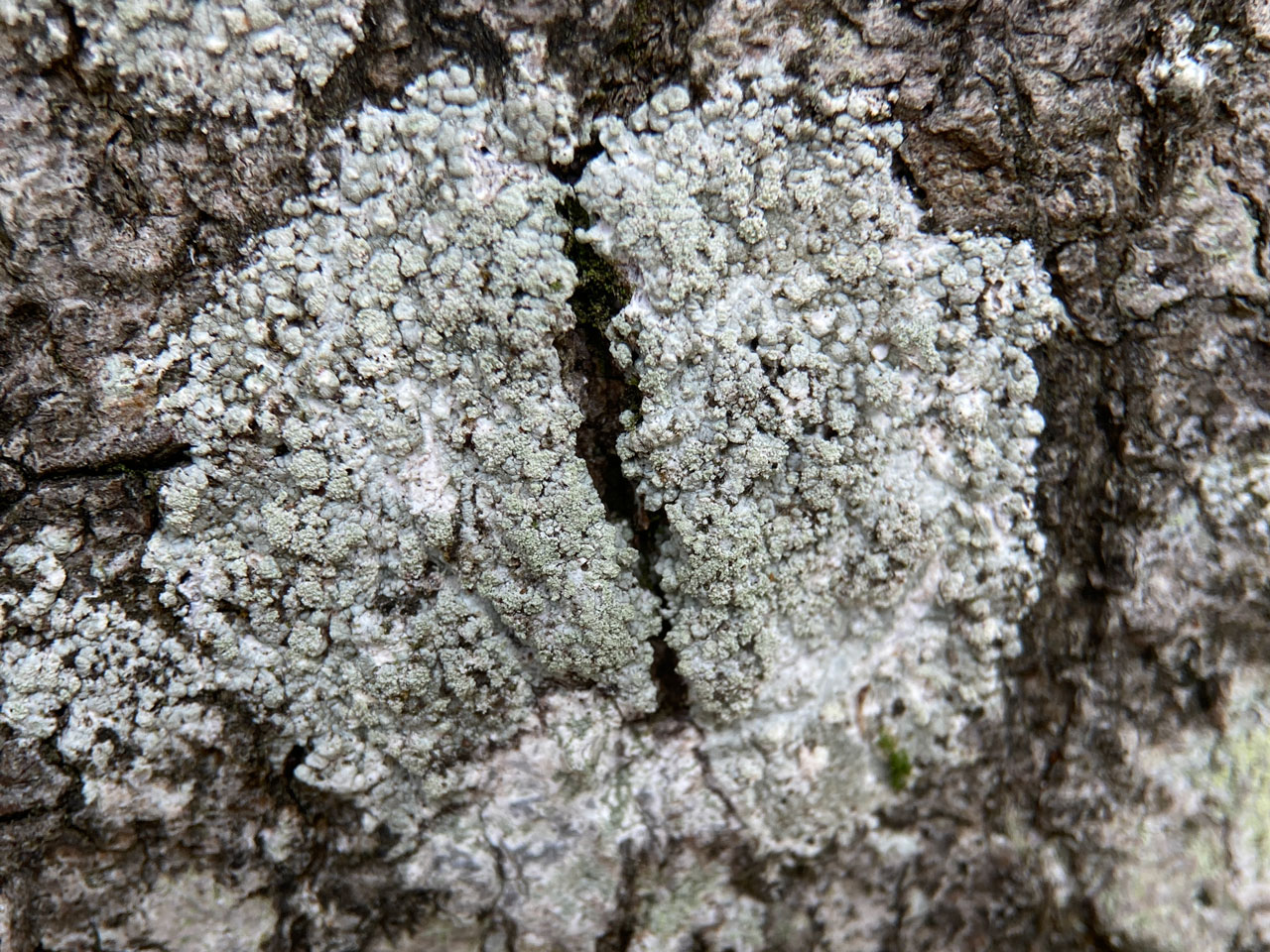Loxospora chloropolia
Loxospora elatina s. lat. was a well known and widespread and usually sterile soridate crust of acid bark and damp lignum in humid old woods. However, this was split into two species by Ptach-Styn et al (2024), Loxospora elatina s. str. and Loxospora chloropolia. The latter appears to be overwhelmingly the most abundant of the two species in Britain and Ireland. The K+ immediately bright yellow, soft soralia distinguishes L. chloropolia from similar species (apart from L. elatina), e.g. Biatora chrysantha, Lecanora alboflavida, Mycoblastus caesius, Mycobilimbia epixanthoides and Varicellaria hemisphaerica.
Thallus crustose, grey, matt or more often shiny, thin, continuous, slightly folded, cracked to cracked-areolate; areoles flat or rarely convex, not constricted at the base. Soralia whitish to greenish-grey, flat or more often convex, rounded or irregular, mostly discrete and separated, bursting from flat parts of thallus or from areoles, sometimes crowded and the neighbouring soralia more or less fused. Soredia to 50 μm diam., often in consoredia to 100 μm diam. Apothecia very rare, to 1.2 mm diam.; thalline margin present, not or partly to completely sorediate; disc reddish brown, thinly white-pruinose; hymenium to 100 μm high; Epithecium straw-brown (K+ pale reddish-brown), with dense granules dissolving in K. Paraphyses not capitate, sometimes anastomosing. Asci 8-spored, with a uniformly KI+ blue apical dome. Ascospores 0–3 (–5)-septate, helically coiled in asci, colourless, fusiform, curved, 35–48 × 5–7 μm. Pycnidia not known. Chemistry: thamnolic acid (major), elatinic acid (minor, trace or absent) and squamatic acid (trace or absent). Cortex, apothecial section, soralia and medulla K+ lemon-yellow, Pd+ yellow to orange, UV–.
Only recently separated from Loxospora elatina s. str. Well developed specimens lacking any tubercles and with the soralia mostly discrete and separated and retaining their identity even where crowded and partly fused are readily field separable from L. elatina s. str. Rare anomalous specimens of Loxospora chloropolia can have tubercles. In this case the soralia on these do not fully coalesce, while those on L. elatina s. str. do fully coalesce at least on part of the thallus, but sequencing is advised to confirm L. elatina s. str. in all cases.
The K+ immediately bright yellow, soft soralia distinguishes L. chloropolia from similar species (apart from L. elatina), e.g. Biatora chrysantha, Lecanora alboflavida, Mycoblastus caesius, Mycobilimbia epixanthoides and Varicellaria hemisphaerica.
On acid-barked trees (Alder, Birch, Aspen, Oak, Holly, Beech and also conifers), less often on damp wood, in old or boggy woodland. Associated with older woodlands, and although not confined to old growth stands, it is much rarer in disturbed woods and is slower to recolonise older young growth stands than species such as Thelotrema lepadinum. An example in the New Forest, where Sanderson (2001) found it on 15 and 32 trees per ha in two old growth stands and 2 – 8 trees per ha in three 19th century Oak plantations.

The majority of past British and Irish records of Loxospora elatina s. lat. are likely to be of Loxospora chloropolia and the map of L. elatina s. lat. will likely largely reflect its true distribution. Loxospora elatina s. lat. has been recorded as widespread in wooded areas across Britain, but very rare to extinct in areas impacted by past sulphur dioxide pollution.
Cannon, P., Coppins, B., Aptroot, A., Sanderson, N. & Simkin, J. (2025). Miscellaneous lichens and lichenicolous fungi, including Aphanopsis and Steinia (Aphanopsidaceae), Arthrorhaphis (Arthrorhaphidaceae), Buelliella, Hemigrapha, Melaspileella, Stictographa and Taeniolella (Asterinales, family unassigned), Phylloblastia (Chaetothyriales, family unassigned) Cystocoleus (Cystocoleaceae), Sclerococcum (Dactylosporaceae), Eiglera (Eigleraceae), Epigloea (Epigloeaceae), Euopsis (Harpidiaceae), Lichenothelia (Lichenotheliaceae), Lichinodium (Lichinodiaceae), Melaspilea (Melaspileaceae), Epithamnolia and Mniaecia (Mniaeciaceae), Lichenostigma (Phaeococcomycetaceae), Pycnora (Pycnoraceae), Racodium (Racodiaceae), Chicitaea and Loxospora (Sarrameanaceae), Schaereria (Schaereriaceae), Strangospora (Strangosporaceae), Botryolepraria and Stigmidium (Verrucariales, family unassigned), and Biatoridium, Mycoglaena, Orphniospora, Piccolia, Psammina and Wadeana (order and family unassigned). Revisions of British and Irish Lichens 57: 1–78.
Ptach-Styn, Ł., Guzow-Krzemińska, B., Lendemer, J.C., Tønsberg ,T., Kukwa, M. (2024) Phylogeny of the genus Loxospora s.l. (Sarrameanales, Lecanoromycetes, Ascomycota), with Chicitaea gen. nov. and five new combinations in Chicitaea and Loxospora. MycoKeys 102: 155–181. https://doi.org/10.3897/mycokeys.102.116196
Sanderson, N. A. (2001) Epiphytic Lichen Monitoring in the New Forest 2000. LIFE Job L33A2U. Lyndhurst: Forest Enterprise.
Text by Neil A. Sanderson based on Cannon et al (2025) and Ptach-Styn (2024)

